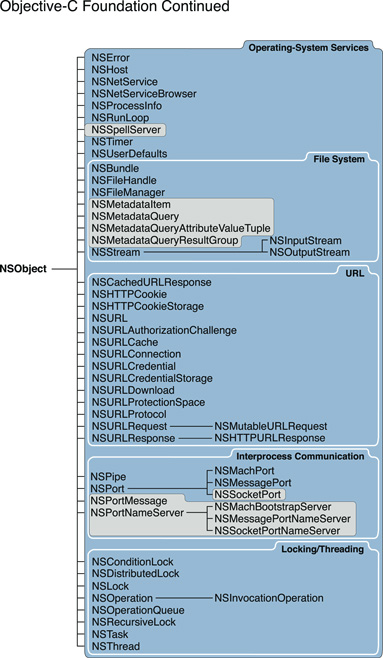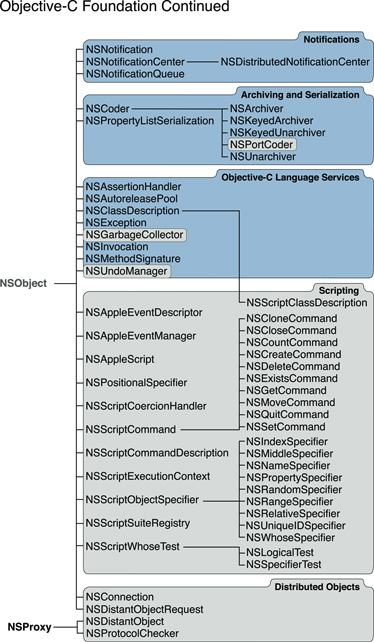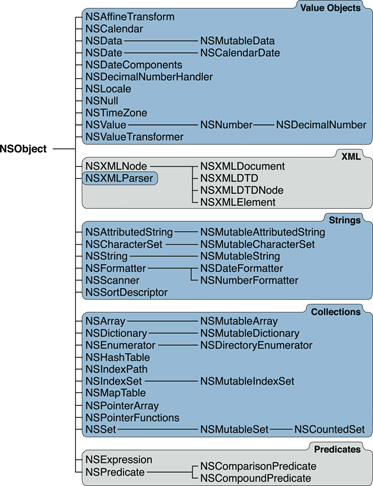The Foundation Framework
| Framework | /System/Library/Frameworks/Foundation.framework |
| Header file directories | /System/Library/Frameworks/Foundation.framework/Headers |
| Declared in | FoundationErrors.h IKPictureTaker.h NSAffineTransform.h NSAppleEventDescriptor.h NSAppleEventManager.h NSAppleScript.h NSArchiver.h NSArray.h NSAttributedString.h NSAutoreleasePool.h NSBundle.h NSByteOrder.h NSCalendar.h NSCalendarDate.h NSCharacterSet.h NSClassDescription.h NSCoder.h NSComparisonPredicate.h NSCompoundPredicate.h NSConnection.h NSData.h NSDate.h NSDateFormatter.h NSDecimal.h NSDecimalNumber.h NSDictionary.h NSDistantObject.h NSDistributedLock.h NSDistributedNotificationCenter.h NSEnumerator.h NSError.h NSException.h NSExpression.h NSFileHandle.h NSFileManager.h NSFormatter.h NSGarbageCollector.h NSGeometry.h NSHFSFileTypes.h NSHTTPCookie.h NSHTTPCookieStorage.h NSHashTable.h NSHost.h NSIndexPath.h NSIndexSet.h NSInvocation.h NSJavaSetup.h NSKeyValueCoding.h NSKeyValueObserving.h NSKeyedArchiver.h NSLocale.h NSLock.h NSMapTable.h NSMetadata.h NSMethodSignature.h NSNetServices.h NSNotification.h NSNotificationQueue.h NSNull.h NSNumberFormatter.h NSObjCRuntime.h NSObject.h NSObjectScripting.h NSOperation.h NSPathUtilities.h NSPointerArray.h NSPointerFunctions.h NSPort.h NSPortCoder.h NSPortMessage.h NSPortNameServer.h NSPredicate.h NSProcessInfo.h NSPropertyList.h NSProtocolChecker.h NSProxy.h NSRange.h NSRunLoop.h NSScanner.h NSScriptClassDescription.h NSScriptCoercionHandler.h NSScriptCommand.h NSScriptCommandDescription.h NSScriptExecutionContext.h NSScriptKeyValueCoding.h NSScriptObjectSpecifiers.h NSScriptStandardSuiteCommands.h NSScriptSuiteRegistry.h NSScriptWhoseTests.h NSSerialization.h NSSet.h NSSortDescriptor.h NSSpellServer.h NSStream.h NSString.h NSTask.h NSThread.h NSTimeZone.h NSTimer.h NSURL.h NSURLAuthenticationChallenge.h NSURLCache.h NSURLConnection.h NSURLCredential.h NSURLCredentialStorage.h NSURLDownload.h NSURLError.h NSURLHandle.h NSURLProtectionSpace.h NSURLProtocol.h NSURLRequest.h NSURLResponse.h NSUndoManager.h NSUserDefaults.h NSValue.h NSValueTransformer.h NSXMLDTD.h NSXMLDTDNode.h NSXMLDocument.h NSXMLElement.h NSXMLNode.h NSXMLNodeOptions.h NSXMLParser.h NSZone.h QTKitDefines.h |
Introduction
The Foundation framework defines a base layer of Objective-C classes. In addition to providing a set of useful primitive object classes, it introduces several paradigms that define functionality not covered by the Objective-C language. The Foundation framework is designed with these goals in mind:
Provide a small set of basic utility classes.
Make software development easier by introducing consistent conventions for things such as deallocation.
Support Unicode strings, object persistence, and object distribution.
Provide a level of OS independence, to enhance portability.
The Foundation framework includes the root object class, classes representing basic data types such as strings and byte arrays, collection classes for storing other objects, classes representing system information such as dates, and classes representing communication ports. See Figure I-1 for a list of those classes that make up the Foundation framework.
The Foundation framework introduces several paradigms to avoid confusion in common situations, and to introduce a level of consistency across class hierarchies. This consistency is done with some standard policies, such as that for object ownership (that is, who is responsible for disposing of objects), and with abstract classes like NSEnumerator. These new paradigms reduce the number of special and exceptional cases in an API and allow you to code more efficiently by reusing the same mechanisms with various kinds of objects.
Foundation Framework Classes
The Foundation class hierarchy is rooted in the Foundation frameworkâÂÂs NSObject class (see Figure I-1). The remainder of the Foundation framework consists of several related groups of classes as well as a few individual classes. Many of the groups form what are called class clustersâÂÂabstract classes that work as umbrella interfaces to a versatile set of private subclasses. NSString and NSMutableString, for example, act as brokers for instances of various private subclasses optimized for different kinds of storage needs. Depending on the method you use to create a string, an instance of the appropriate optimized class will be returned to you.
Note: In the following class-hierarchy diagrams, blue-shaded areas include classes that are available in Mac OS X and iPhone OS; gray-shaded areas include classes that are available in Mac OS X only.


Many of these classes have closely related functionality:
Data storage.
NSDataandNSStringprovide object-oriented storage for arrays of bytes. NSValue and NSNumber provide object-oriented storage for arrays of simple C data values.NSArray,NSDictionary, andNSSetprovide storage for Objective-C objects of any class.Text and strings.
NSCharacterSetrepresents various groupings of characters that are used by theNSStringandNSScannerclasses. TheNSStringclasses represent text strings and provide methods for searching, combining, and comparing strings. AnNSScannerobject is used to scan numbers and words from anNSStringobject.Dates and times. The
NSDate,NSTimeZone, andNSCalendarclasses store times and dates and represent calendrical information. They offer methods for calculating date and time differences. Together withNSLocale, they provide methods for displaying dates and times in many formats, and for adjusting times and dates based on location in the world.Application coordination and timing.
NSNotification,NSNotificationCenter, andNSNotificationQueueprovide systems that an object can use to notify all interested observers of changes that occur. You can use an NSTimer object to send a message to another object at specific intervals.Object creation and disposal.
NSAutoreleasePoolis used to implement the delayed-release feature of the Foundation framework.Object distribution and persistence. The data that an object contains can be represented in an architecture-independent way using
NSPropertyListSerialization. TheNSCoderand its subclasses take this process a step further by allowing class information to be stored along with the data. The resulting representations are used for archiving and for object distribution.Operating-system services. Several classes are designed to insulate you from the idiosyncrasies of various operating systems.
NSFileManagerprovides a consistent interface for file operations (creating, renaming, deleting, and so on).NSThreadandNSProcessInfolet you create multithreaded applications and query the environment in which an application runs.URL loading system. A set of classes and protocols provide access to common Internet protocols.
© 1997, 2008 Apple Inc. All Rights Reserved. (Last updated: 2008-06-27)
